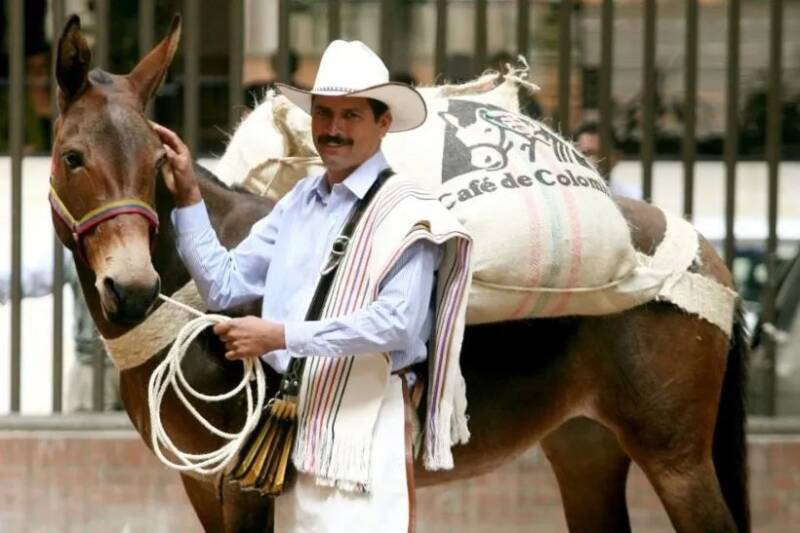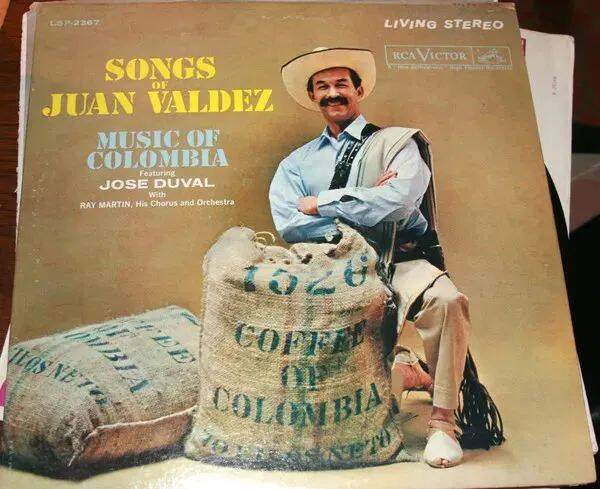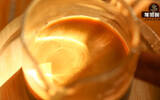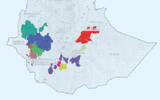The Top Ten Coffee in the World-Uncle Juan, the originator of Columbia Coffee Network
A little friend who likes Colombian coffee must be no stranger to a barista with a mule. He is Juan Valdez, perhaps the most famous coffee grower of all time. You may see his real face on TV or even in movies, and his friends who know him affectionately call him "Uncle Juan."

Who is Uncle Juan?
In fact, Uncle Juan Valdez is a representative figure of Colombian coffee created and launched by the Colombian Coffee producers Association FNC in 1959, but in fact Uncle Juan is a virtual character.
Uncle Juan's story begins with the story of Colombian coffee growers. Today there are about 550000 coffee growers in Colombia who own small farms. Including family members and others directly or indirectly engaged in the coffee industry, millions of people in Colombia depend on coffee for their livelihood.

When it comes to Uncle Juan, we often can't ignore the mule "Conchita" with a Colombian coffee sack behind him.
In Colombia, coffee farmers actually use mules to carry coffee from the mountains. As the main coffee-growing areas in Colombia are located in the Andes with three "Chuan" characters, and the rugged mountain roads make it difficult for traffic, farmers mostly use mules as a means of transport. With such unique geographical conditions, even with the development of transportation and science and technology, mules are still one of the right-hand men of farmers.
To some extent, Juan Valdez, with a mule, a bushy beard, overalls, a Colombian cloak "Poncho" and a distinctive straw hat "Aguadeno", represents a large number of coffee growers. Although he is modelled on a typical male coffee grower in the Pisa region of central Colombia, his image still represents every coffee grower in the country.
The historical origin of Uncle Juan
Founded in 1927, FNC is committed to the improvement and promotion of Colombian coffee quality. After 30 years of development, Colombian coffee quality has won the recognition and trust of many major coffee brands around the world. But in fact, consumers at that time did not know what Colombian coffee tasted like, because Colombian coffee at that time was mostly used in coffee blending.
The American market consumed 77% of Colombia's coffee production at the time, but only about 4% of American consumers knew that Colombia was a coffee producer. FNC aims to reverse this situation and at the same time further promote coffee consumption in Colombia in the United States. In 1958, FNC hired a New York City marketing agency (DDB) to carry out an advertising campaign, which advised them to find a symbolic figure for all Colombian coffee growers and use it as a promotional image.
A year later, the charismatic and influential Uncle Juan and his mule Kenchita were born to promote Colombian coffee as a single-origin product and a symbol of high-quality coffee. It is said that in the five months since Uncle Juan's image was launched, the number of Colombian coffee consumers has increased by nearly 300%. The marketing campaign has achieved gratifying results and was once rated as one of the top five most recognized images in the world.
The birth of Uncle Juan has given consumers a more concrete understanding of Colombian coffee. They can see coffee growers planting and picking in the Andes on TV, and gradually begin to recognize and pay attention to the country of origin as a commitment to the quality of development. Just as wines from certain regions or countries are appreciated, coffee begins to have the opportunity to shine.
Colombian Coffee Triangle and Uncle Juan
The Colombian coffee triangle as we know it today was born in the early 1980s. At that time, in order to further win the consensus of Colombian coffee consumers around the world and ensure that consumers could drink the purest Colombian coffee, FNC established a factor brand with coffee roasters to ensure the use of 100% Colombian coffee raw materials from the source, that is, the 100% Colombian Coffee Project (100Caf é de Colombia).
Designed by DDB in 1981, the logo is made up of Uncle Juan Valdez and Conchita, and is set against a background of triangles symbolizing the Andes, with "100% Caf é de Colombia" written underneath. The emergence of this logo seal has enabled Colombian coffee to emerge on the world map as a single-origin coffee, creating a sense of brand recognition and belonging to consumers and a clearer understanding of where the coffee comes from.
Today's Uncle Juan is more than just an image representative. Juan Valdez Cafe, a cafe of the same name, was founded in 2002. There are hundreds of chain coffee shops in about a dozen countries around the world. Here, you will find traditional Colombian floor tiles reminiscent of the vegetated vertical gardens of coffee-growing areas and wooden tables made of recycled coffee trees. Of course, there is also familiar burlap out of the pocket.
I don't know if you are curious about Uncle Juan when you read here. If you have a chance to taste the unique charm of Colombian coffee.
-END-
Front Street Cafe
No. 10 Baoqian street, Yandun road, Dongshankou, Yuexiu district, Guangzhou, Guangdong province
Important Notice :
前街咖啡 FrontStreet Coffee has moved to new addredd:
FrontStreet Coffee Address: 315,Donghua East Road,GuangZhou
Tel:020 38364473
- Prev

Is the golden foam of espresso grease or Crema? Is the grease as thick as possible?
Not long ago, in "the oil of espresso is so bitter, why do people still like it?" In the article, Qianjie shared that this layer of golden foam pressed by an Italian coffee machine is called Crema/ grease, so a friend asked backstage: is it Crema or grease? I can go first.
- Next

Introduction of Ethiopian Coffee Yega Xuefei, Cochelle and Guodingding Cooperative
Ethiopia is the largest Arabica coffee producer in Africa and has a long history of coffee. And there are a wide variety of coffee, and it is estimated that there are now 10000 to 15000 coffee varieties in Ethiopia, most of which have not yet been formally identified. Ethiopia has many famous coffee products.
Related
- What is the standard process for the purpose of coffee cup testing? What is the difference between hand-brewed coffee and cup testing?
- How to use hand-brewed coffee paragon small golden balls? How does cold coffee lock in the aroma of coffee?
- Is American coffee black? What is the difference between American coffee and drip coffee?
- Unexpected! Well-known tea beverage brand Lele Tea will withdraw from the Zhengzhou market!
- Starbucks enters the fashion and beauty industry?! Netizen: Give me an ice American eye cream
- Why can American refills for free? The difference between Americano and American drip pot coffee
- Being chased out of the rain in front of Starbucks?! Store: Sheltering from rain under umbrellas poses a safety hazard
- The white moonlight has changed?! Lucky launches "Big Winter Pear American"
- Hand-brewed coffee three-stage method, high-sweet and universal brewing method to share! What does the high sweet water level of hand-brewed coffee mean?
- What is the difference between raw, refined and full espresso coffee? How to extract espresso and taste good?

